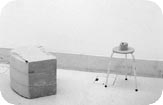|
 Breughel Project / Casa Malaparte, 1999, installation
Breughel Project / Casa Malaparte, 1999, installation
Ian Kiaer's work for Manifesta 3 has very complex sources,
Brueghel and Curzio Malaparte and their respective relationships
to the Italian landscape. In 1552 Pieter Brueghel journeyed
across the Alps to Rome and then on to Sicily. His View of
the Bay of Naples suggests that he passed through the part
of Italy where Curzio Malaparte was to be exiled by Mussolini
a few centuries later, in 1933. The rocky outcroppings of
those Mediterranean shores appear in his subsequent paintings,
Christ at the Lake of Tiberias and The Fall of Icarus. Along
the journey Brueghel made remarkably detailed topographical
drawings of the landscape. These were often of hills and mountains,
built up with short marks and dots, where he snugly fitted
villages or solitary buildings into distant crags. Malaparte
made use of his two and a half years of exile by immersing
himself in the reading of Homer's poetry, Greek classics,
and Italian lyric poetry. As with Brueghel's travels, his
isolation was a defining period, far from the political and
social attention which he had enjoyed. It was his exile in
Ischia, an island close to Capri, which gave him the idea
of building a retreat. Inspired by his environment and recent
reading, he set about trying to acquire a piece of land as
soon as his confinement ended. In 1938 work began in collaboration
with the architect Adalberto Libera on a rocky promontory
above the Tyrrhenian Sea. In 1564 Brueghel painted The Procession
to Calvary. A semi-circular procession makes its way towards
Golgotha. Christ is central to the composition, yet is almost
lost in the crowd. In the background stands an improbable
rock with a windmill perched atop. It is a makeshift, vernacular
building whose function is obvious, yet its architect/painter
has designed it with utmost care. Its windows, though small,
give controlled glimpses of the epic panorama below.

|
|

